2009 KIA SOUL engine oil
[x] Cancel search: engine oilPage 280 of 328
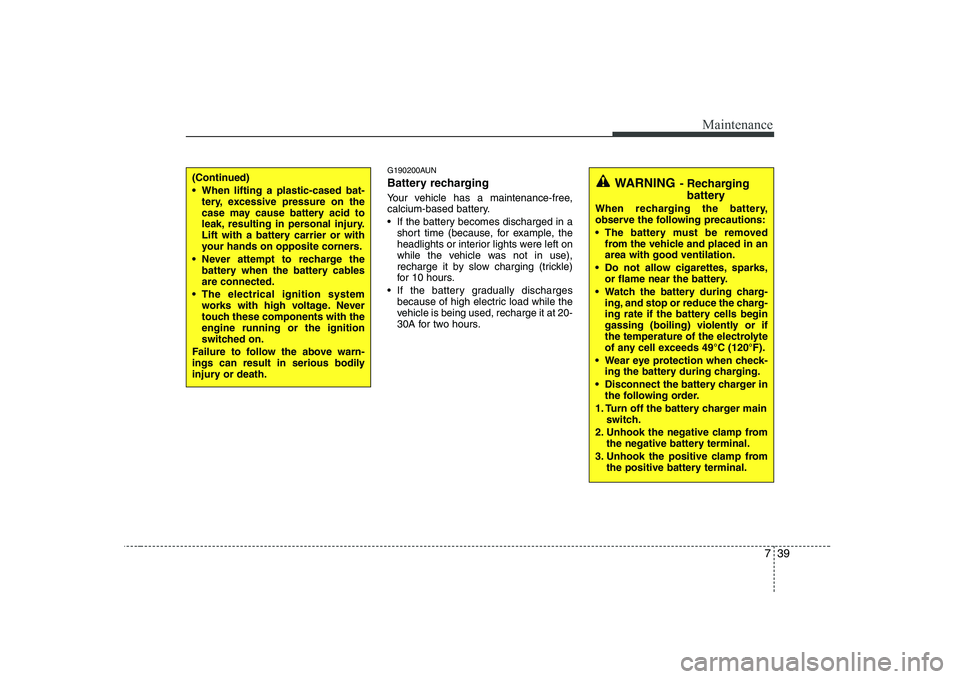
739
Maintenance
G190200AUN
Battery recharging
Your vehicle has a maintenance-free,
calcium-based battery.
If the battery becomes discharged in ashort time (because, for example, the
headlights or interior lights were left on
while the vehicle was not in use),
recharge it by slow charging (trickle)
for 10 hours.
If the battery gradually discharges because of high electric load while the
vehicle is being used, recharge it at 20-
30A for two hours.(Continued)
When lifting a plastic-cased bat- tery, excessive pressure on the
case may cause battery acid to
leak, resulting in personal injury.
Lift with a battery carrier or with
your hands on opposite corners.
Never attempt to recharge the battery when the battery cablesare connected.
The electrical ignition system works with high voltage. Never
touch these components with theengine running or the ignition
switched on.
Failure to follow the above warn-
ings can result in serious bodily
injury or death.WARNING - Recharging
battery
When recharging the battery,
observe the following precautions:
The battery must be removed from the vehicle and placed in an area with good ventilation.
Do not allow cigarettes, sparks, or flame near the battery.
Watch the battery during charg- ing, and stop or reduce the charg-
ing rate if the battery cells begin
gassing (boiling) violently or if
the temperature of the electrolyte
of any cell exceeds 49°C (120°F).
Wear eye protection when check- ing the battery during charging.
Disconnect the battery charger in the following order.
1. Turn off the battery charger main switch.
2. Unhook the negative clamp from the negative battery terminal.
3. Unhook the positive clamp from the positive battery terminal.
Page 300 of 328
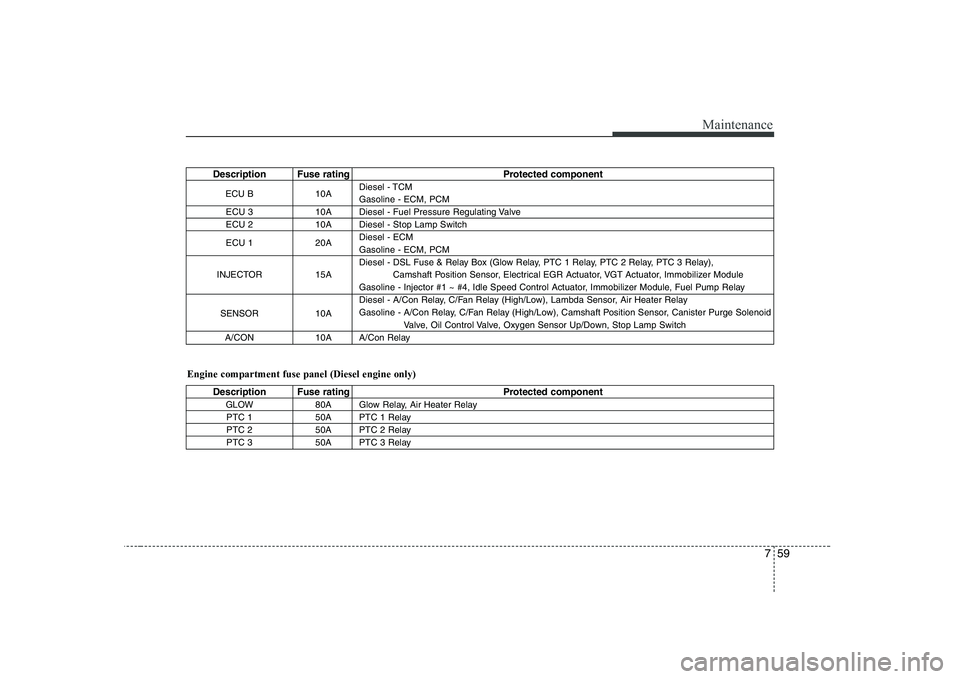
759
Maintenance
Description Fuse rating Protected componentECU B 10A Diesel - TCM Gasoline - ECM, PCM
ECU 3 10A Diesel - Fuel Pressure Regulating Valve
ECU 2 10A Diesel - Stop Lamp Switch
ECU 1 20A Diesel - ECM Gasoline - ECM, PCM
INJECTOR 15A Diesel - DSL Fuse & Relay Box (Glow Relay, PTC 1 Relay, PTC 2 Relay, PTC 3 Relay),
Camshaft Position Sensor, Electrical EGR Actuator, VGT Actuator, Immobilizer Module
Gasoline - Injector #1 ~ #4, Idle Speed Control Actuator, Immobilizer Module, Fuel Pump Relay
SENSOR 10A Diesel - A/Con Relay, C/Fan Relay (High/Low), Lambda Sensor, Air Heater Relay
Gasoline - A/Con Relay, C/Fan Relay (High/Low), Camshaft Position Sensor, Canister Purge Solenoid
Valve, Oil Control Valve, Oxygen Sensor Up/Down, Stop Lamp Switch
A/CON 10A A/Con Relay
Engine compartment fuse panel (Diesel engine only)
Description Fuse rating Protected component GLOW 80A Glow Relay, Air Heater Relay PTC 1 50A PTC 1 Relay
PTC 2 50A PTC 2 Relay
PTC 3 50A PTC 3 Relay
Page 321 of 328
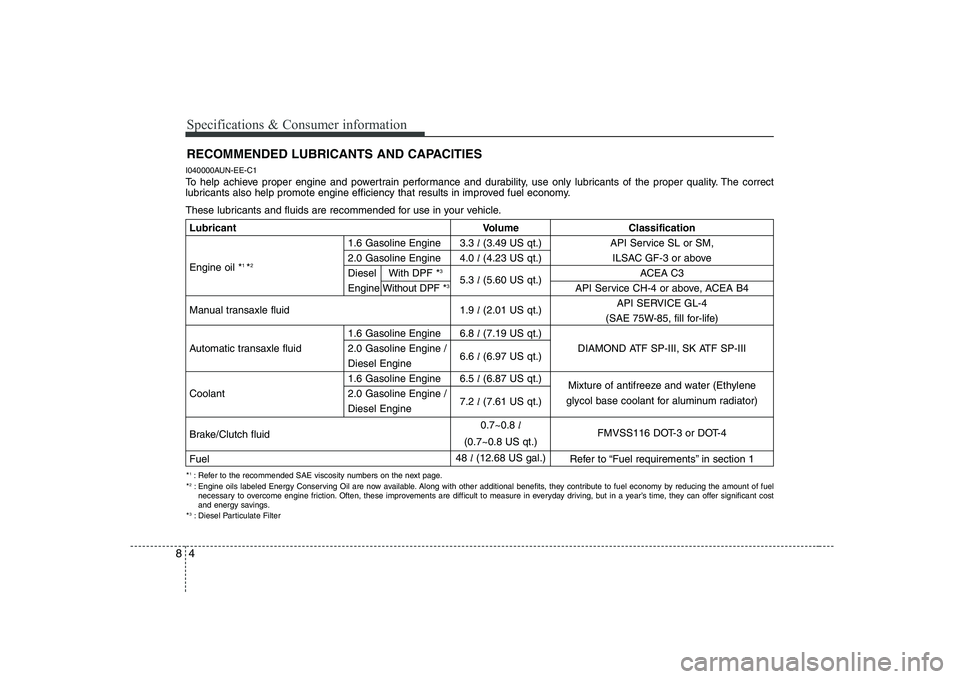
Specifications & Consumer information
4
8
RECOMMENDED LUBRICANTS AND CAPACITIES
I040000AUN-EE-C1
To help achieve proper engine and powertrain performance and durability, use only lubricants of the proper quality. The correct
lubricants also help promote engine efficiency that results in improved fuel economy.
These lubricants and fluids are recommended for use in your vehicle.
* 1
: Refer to the recommended SAE viscosity numbers on the next page.
* 2
: Engine oils labeled Energy Conserving Oil are now available. Along with other additional benefits, they contribute to fuel economy by reducing the amount of fuel
necessary to overcome engine friction. Often, these improvements are difficult to measure in everyday driving, but in a year’s time, they can offer significant cost
and energy savings.
* 3
: Diesel Particulate Filter
Lubricant Volume Classification
1.6 Gasoline Engine 3.3 l(3.49 US qt.) API Service SL or SM,
2.0 Gasoline Engine 4.0 l(4.23 US qt.) ILSAC GF-3 or above
Engine oil * 1
*2
Diesel With DPF *3
5.3 l(5.60 US qt.) ACEA C3
Engine Without DPF * 3
API Service CH-4 or above, ACEA B4
Manual transaxle fluid 1.9 l(2.01 US qt.) API SERVICE GL-4
(SAE 75W-85, fill for-life)
1.6 Gasoline Engine 6.8 l(7.19 US qt.)
Automatic transaxle fluid 2.0 Gasoline Engine / 6.6 l(6.97 US qt.) DIAMOND ATF SP-III, SK ATF SP-III
Diesel Engine
1.6 Gasoline Engine 6.5 l(6.87 US qt.)
Mixture of antifreeze and water (Ethylene
Coolant 2.0 Gasoline Engine / 7.2 l(7.61 US qt.)
Diesel Engine glycol base coolant for aluminum radiator)
Brake/Clutch fluid 0.7~0.8
l
FMVSS116 DOT-3 or DOT-4
(0.7~0.8 US qt.)
Fuel 48
l(12.68 US gal.)
Refer to “Fuel requirements” in section 1
Page 322 of 328
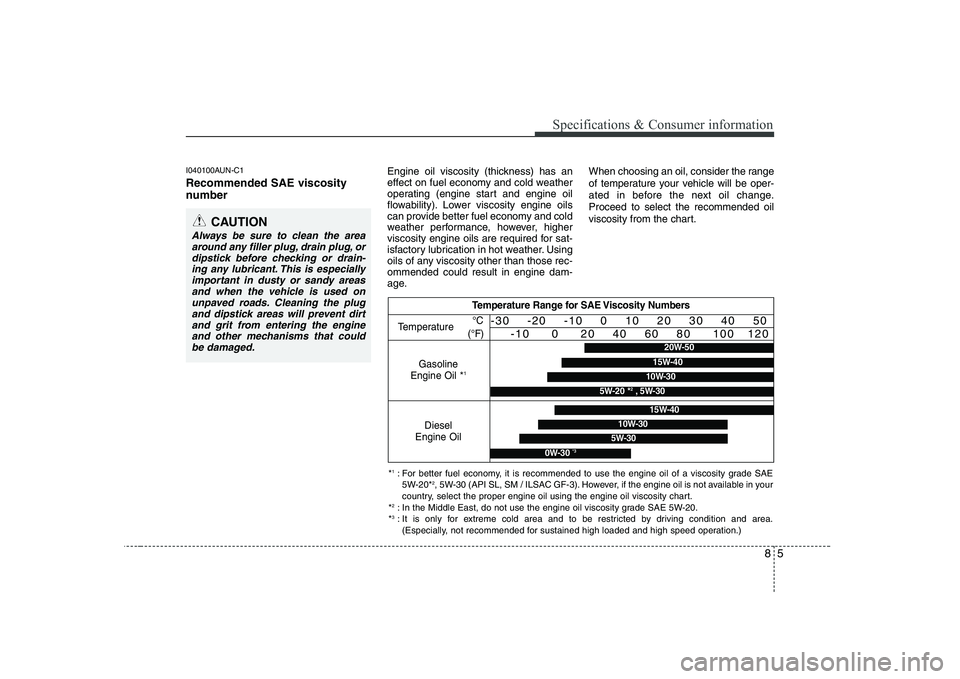
85
Specifications & Consumer information
I040100AUN-C1 Recommended SAE viscosity
number Engine oil viscosity (thickness) has an
effect on fuel economy and cold weather
operating (engine start and engine oil
flowability). Lower viscosity engine oils
can provide better fuel economy and cold
weather performance, however, higher
viscosity engine oils are required for sat-
isfactory lubrication in hot weather. Using
oils of any viscosity other than those rec-ommended could result in engine dam-
age.When choosing an oil, consider the range
of temperature your vehicle will be oper-
ated in before the next oil change.Proceed to select the recommended oil
viscosity from the chart.
CAUTION
Always be sure to clean the area
around any filler plug, drain plug, ordipstick before checking or drain- ing any lubricant. This is especially
important in dusty or sandy areasand when the vehicle is used on unpaved roads. Cleaning the plugand dipstick areas will prevent dirt
and grit from entering the engineand other mechanisms that could be damaged.
Temperature Range for SAE Viscosity Numbers
Temperature
Gasoline
Engine Oil *
1
°C
(°F)-30 -20 -10 0 10 20 30 40 50 -10 0 20 40 60 80 100 120
Diesel
Engine Oil
5W-30
15W-40
10W-30
0W-30 *3
*1
: For better fuel economy, it is recommended to use the engine oil of a viscosity grade SAE
5W-20* 2
, 5W-30 (API SL, SM / ILSAC GF-3). However, if the engine oil is not available in your
country, select the proper engine oil using the engine oil viscosity chart.
* 2
: In the Middle East, do not use the engine oil viscosity grade SAE 5W-20.
* 3
: It is only for extreme cold area and to be restricted by driving condition and area.
(Especially, not recommended for sustained high loaded and high speed operation.)
20W-50
10W-30
15W-40
5W-20 * 2
, 5W-30
Page 326 of 328
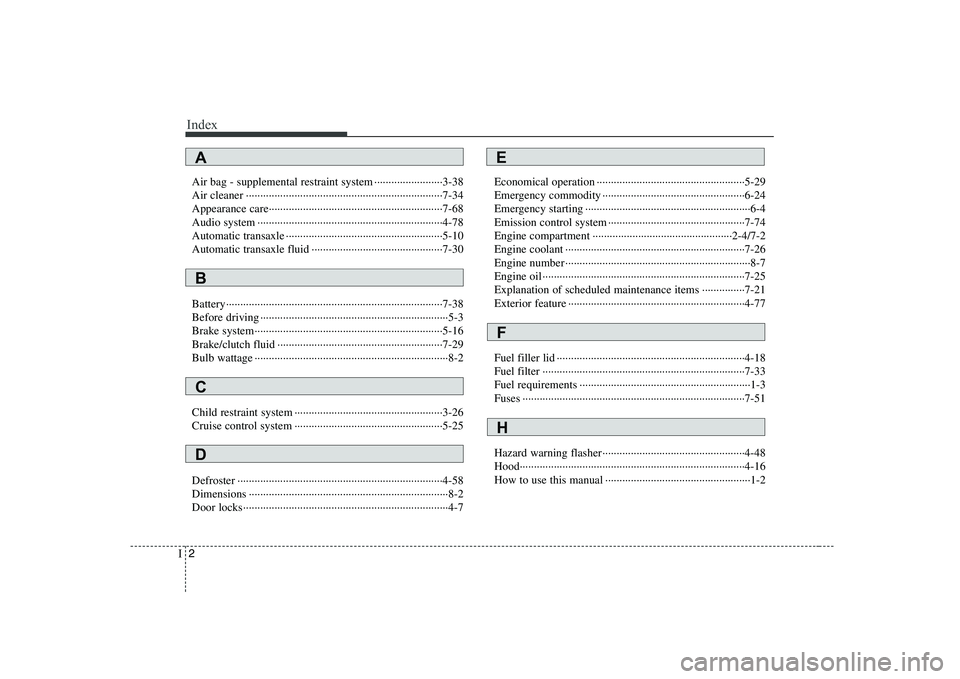
Index
2
I
Air bag - supplemental restraint system ························3-38
Air cleaner ·····································································7-34
Appearance care·····························································7-68
Audio system ·································································4-78
Automatic transaxle ·······················································5-10
Automatic transaxle fluid ··············································7-30
Battery············································································7-38
Before driving ··································································5-3
Brake system··································································5-16
Brake/clutch fluid ··························································7-29
Bulb wattage ····································································8-2
Child restraint system ····················································3-26
Cruise control system ····················································5-25
Defroster ········································································4-58
Dimensions ······································································8-2
Door locks········································································4-7 Economical operation ····················································5-29
Emergency commodity ··················································6-24
Emergency starting ··························································6-4
Emission control system ················································7-74
Engine compartment ·················································2-4/7-2
Engine coolant ·······························································7-26
Engine number ·································································8-7
Engine oil ·······································································7-25
Explanation of scheduled maintenance items ···············7-21
Exterior feature ······························································4-77
Fuel filler lid ··································································4-18
Fuel filter ·······································································7-33
Fuel requirements ····························································1-3
Fuses ··············································································7-51
Hazard warning flasher··················································4-48
Hood···············································································4-16
How to use this manual ···················································1-2
A
B
C
D
E
F
H